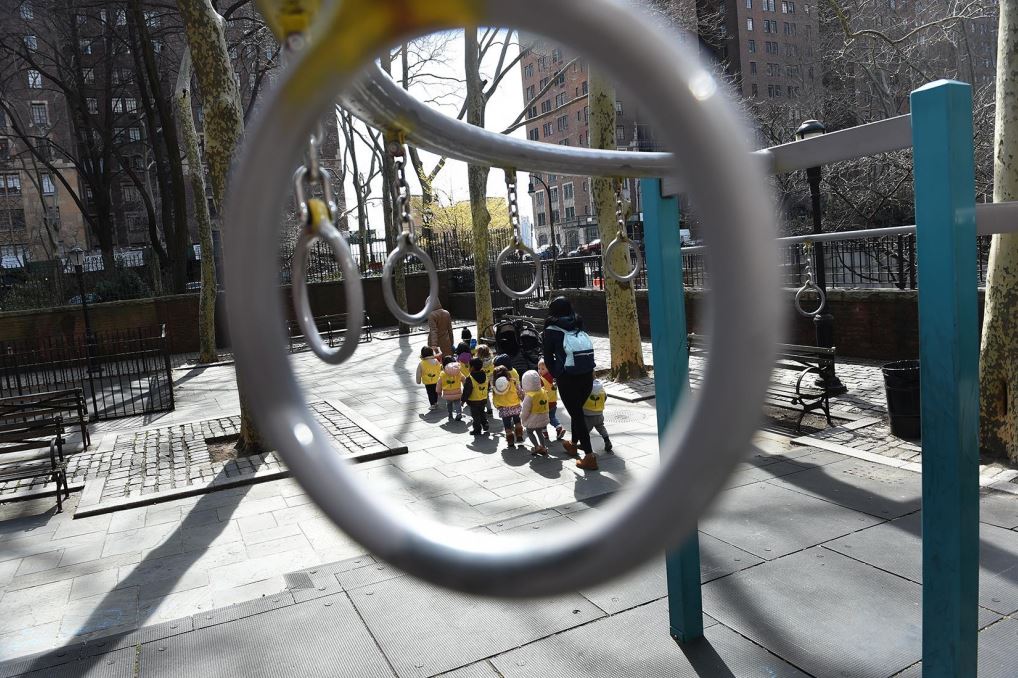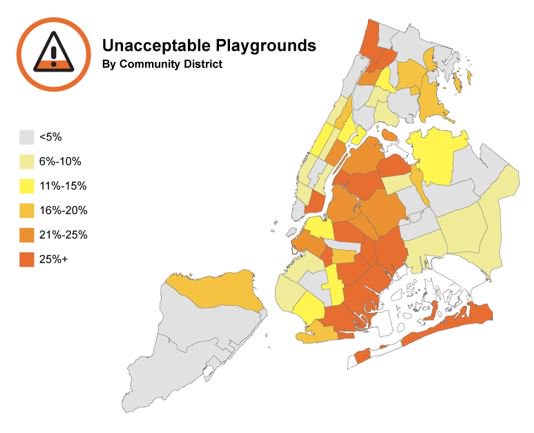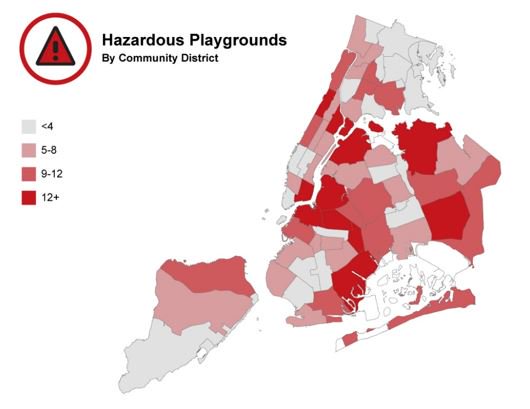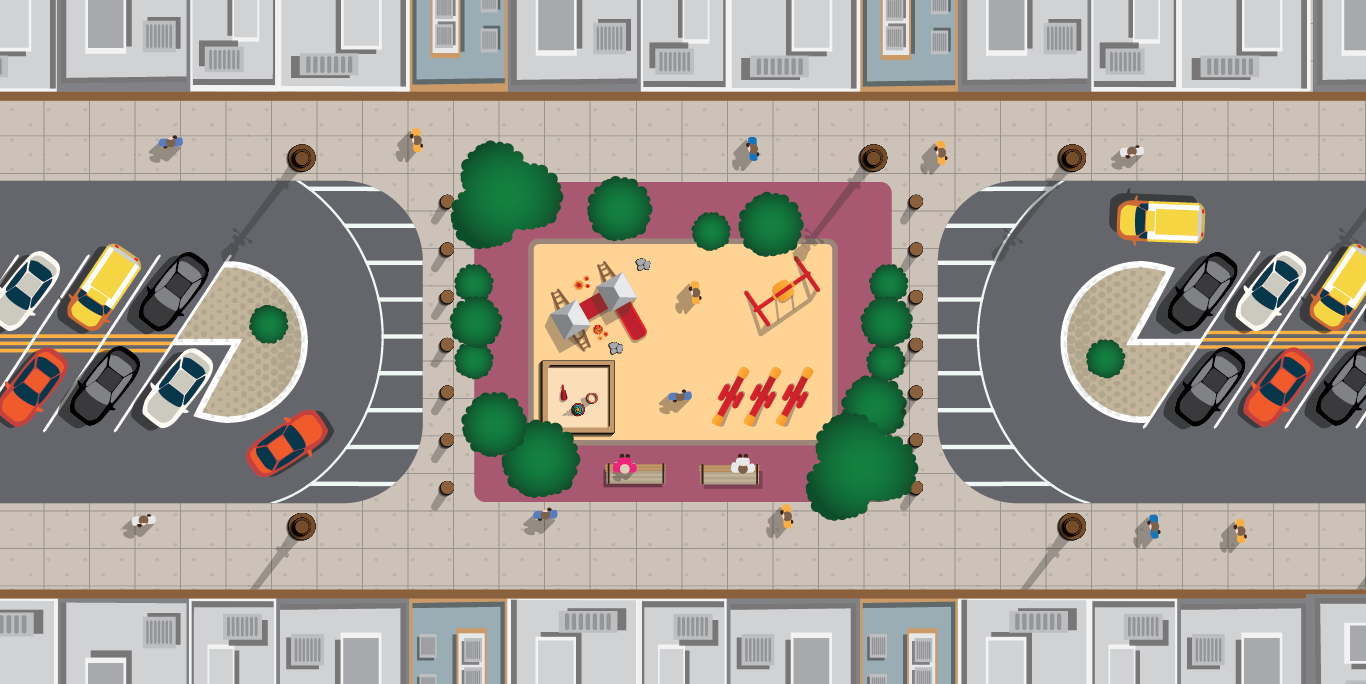
Playground construction is failing to keep pace with the growing population of children in several neighborhoods
Brooklyn is the most under-served borough, with only eight playgrounds for every 10,000 children
Playground maintenance is completely inadequate, with 521 NYC Parks playgrounds having at least one hazardous feature requiring “immediate attention”
Comptroller Stringer launches “Pavement to Playgrounds” campaign, utilizing an innovative model for building out city playgrounds and calling for the construction of 200 new playgrounds in the next five years
(New York, NY) — Today, New York City Comptroller Scott M. Stringer released a new report, “State of Play: A New Model for NYC Playgrounds,” documenting a severe shortage of playgrounds in New York City, particularly in neighborhoods that have seen the fastest population growth. Access to playgrounds varies significantly across community districts, with some containing more than triple the number of playgrounds as others on a per child basis, and neighborhoods with the largest population of children — e.g. Bensonhurst, Borough Park, Corona, Richmond Hill, and Flatbush — having fewer than four NYC Parks playgrounds for every 10,000 children. Looking more broadly, New York City ranks a lowly 48th in playgrounds per capita among the 100 largest American cities, evidence that the City has not sufficiently invested in recreational facilities and failed to anticipate, prepare, and respond to shifting demographics.
Meanwhile, conditions at hundreds of NYC Parks playgrounds were found to be substandard during their latest inspections. In 2018, inspectors found that 521 NYC Parks playgrounds had at least one hazardous feature that required “immediate attention.” These included 807 “Priority 2 Hazards” that “present the chance of slight to moderate injury” and 29 “Priority 1 Hazards” that “present the chance of life-threatening or debilitating injury.”
To address this urgent need, Comptroller Stringer outlined sweeping recommendations for reform, including calling on the City to build 200 new playgrounds in the next five years. Many of these new facilities would be built through Stringer’s newly envisioned “Pavement to Playgrounds” program — a proposed partnership between NYC Parks, the New York City Department of Transportation (DOT), local nonprofits, and community boards — to construct playgrounds and plazas on lightly used residential blocks. Other recommendations from the report include dramatically expanding the successful “Schoolyards to Playgrounds” program, increasing resources for NYC Parks maintenance, developing stronger protections for “Jointly Operated Playgrounds” on DOE property, and ensuring that playgrounds are designed to serve a wide range of ages to better promote learning, playing, and socializing.
“Playgrounds are essential public spaces, offering children a place to socialize, learn, be active, and exercise their imaginations. They are also spaces for children and families to meet their neighbors and develop strong bonds. But our findings reveal stark disparities in access to these critical public spaces in New York City,” said Comptroller Stringer. “That’s why our City needs to overhaul the planning, construction, and maintenance of our playground system. We can make a major impact on the lives and health of New York City children by substantially expanding the number of playgrounds in neighborhoods that are in dire need of these spaces, while also ensuring they are well-maintained and safe for every child.”
The State of New York City’s Playgrounds
Comptroller Stringer’s report examined all 2,067 municipal playgrounds in New York City, of which 1,028 are overseen by Parks, 796 are managed by NYCHA, and 243 are “Schoolyards to Playgrounds” conversions co-administered by NYC Parks and the New York City Department of Education (DOE).
Playgrounds 1,028 | Playgrounds 796 | Playgrounds Conversions 243 | TOTAL 2,067 |
Brooklyn is the most underserved borough, with only 8 playgrounds for every 10,000 children under the age of ten years old. Manhattan had 15 and Staten Island had 11 playgrounds per 10,000 children.
In eight Community Districts (CD), there are fewer than five playgrounds for every 10,000 children, including: Crown Heights South & Prospect Lefferts (CD9), Flatbush & Midwood (CD14), Bensonhurst (CD11), Borough Park (CD12), Jackson Heights (CD3), and Woodhaven & Richmond Hill (CD9).
To a large extent, these disparities are driven by a failure to anticipate, prepare for, and respond to changing demographics in our city. For instance, in the 15 neighborhoods with the lowest ratio of playgrounds, the number of local children increased by a robust 14 percent in recent years, from 275,088 in 2010 to 313,122 in 2017—or 89 percent of the net growth in children city-wide.
A Lack of Safety
Comptroller Stringer’s report also found that hundreds of NYC Parks playgrounds were rated as “unacceptable” by Parks Inspection Program inspectors due to a) multiple features being unsatisfactory, b) one feature having a serious safety hazard, or c) the playground having a failed cleanliness rating.

Brooklyn had 24 percent of its playgrounds designated as “unacceptable” — the highest percentage citywide.
More than 25 percent of playgrounds were found to be “unacceptable” in 12 Community Districts, including one in Manhattan, two in the Bronx, three in Queens, and six in Brooklyn (see above).
521 NYC Parks playgrounds had at least one “hazardous feature” that required immediate attention (see below). This included 52 pieces of play equipment, 34 benches, 42 fences, and 282 paved and safety surfaces that presented a chance of injury.

Pavement to Playgrounds: An Innovative Approach to Scaling Up our Playground Network
Comptroller Stringer’s report outlined a new model for building out New York City playgrounds, inspired by a small neighborhood playground in Crown Heights. In partnership with DOT and local community boards, NYC Parks would identify neighborhood streets with minimal through traffic — either disconnected from the local grid or at dead ends — and build playgrounds mid-block (see rendering below). Angled street parking would be introduced so that the total number of parking spots would remain constant.

Expanding the “Schoolyards to Playgrounds” Program
Comptroller Stringer’s report highlighted the success of the City’s “Schoolyards to Playgrounds” program, a partnership between NYC Parks, the New York City Department of Education (DOE), the New York City School Construction Authority (SCA), and the Trust for Public Land.

Comptroller Stringer called for an additional 100 “Schoolyard to Playground” conversions in the next five years, specifically targeting high-need neighborhoods in the Bronx, Brooklyn, and Queens that have experienced a substantial increase in their youth population.
Maintenance for Playgrounds
Given the high number of playgrounds with hazardous conditions, Comptroller Stringer called on NYC Parks to prioritize playground maintenance to ensure hazardous conditions are addressed through increased funding for maintenance and operations. These budget increases should be consistent with proposals outlined by the Play Fair Coalition — a consortium of more than 100 community-based organizations as well as NYC Parks employees.
“Parks are one of New York City’s more important environmental assets but many of them suffer from poor maintenance and upkeep,” said Julie Tighe, President of the New York League of Conservation Voters. “We thank Comptroller Stringer for this report, which emphasizes the need for investment and also highlights the inequity that exists in the upkeep of parks and playgrounds from community to community. We are grateful that he is joining the Play Fair campaign in calling for more investment in maintaining parks, playgrounds, and green spaces across the city.”
“We’re thrilled that Comptroller Stringer supports a robust park playground system for New York City, and is calling for investment in NYC Parks consistent with what we and other members of the Play Fair Coalition are demanding,” said Lynn Kelly, Executive Director of New Yorkers for Parks. “Current NYC Parks funding is wholly inadequate, and the $100 million in expense funding that the Coalition and Comptroller Stringer are calling for will ensure that playgrounds across the city are safe, clean, and well-maintained.”
“Young people in New York City face many challenges and a lack of open spaces for them to play is one of them,” said Rebecca Faulkner, Executive Director of play:groundNYC. “By animating public space through play, and repurposing and revitalizing plazas, parks and city blocks with recycled materials and loose parts, we can begin to transform the urban environment for the next generation, and subsequently for all of us.”
“New Yorkers often complain about the lack of space in this city,” said Thomas DeVito, Senior Director of Advocacy of Transportation Alternatives. “In fact, this frustration is so universally felt that it seems to be the underlying theme of most of the ad campaigns we’re subjected to. What is less known, however, is that it isn’t entirely true. There is actually a lot of space, it’s just that we use what’s available to us thoughtlessly. 17 square miles of New York City is dedicated to storing cars on our streets — that’s 13 Central Parks that we are giving away and getting nothing communal in return. This model is a great way to start re-imagining street space to accommodate more varied neighborhood uses, including play areas for our kids. Let’s start implementing these projects and building streets for people, not cars.”
“We’re glad to see the Comptroller’s report on converting more underused roads to community spaces,” said Nick Sifuentes, Executive Director of Tri-State Transportation Campaign. “Lack of shared spaces like parks and playgrounds in our city doesn’t just harm children — it also impacts parents, the environment, and the greater community. As we work to make cities more livable, we must challenge the common view that streets are only for cars and car drivers. Repurposing streets with low-volume car traffic into child-friendly spaces is an important step to creating healthier, more livable neighborhoods.”
To read Comptroller Stringer’s full report and recommendations on expanding and reforming the city’s playgrounds, click here.
